Recent Water Damage Posts
Tips for Avoiding Water Damage in Your Home This Summer
5/31/2023 (Permalink)
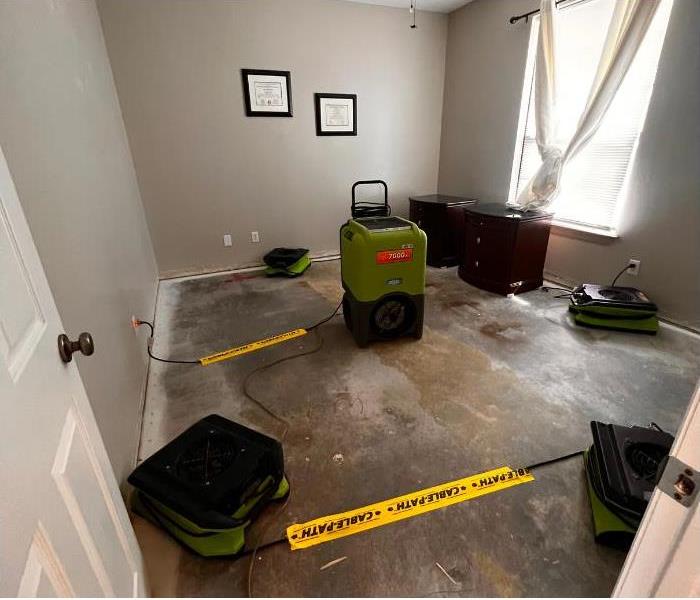 When water damage strikes your home
When water damage strikes your home
It doesn’t matter how big or small your property is, water damage is always incredibly damaging. Even if it feels warmer and drier, one thing to bear in mind during the summer season is water damage. Irrigation systems, summer storms, and a range of other factors can all pose potential hazards to your home. You can prevent more significant damage by taking measures and being aware of the main signs of damage. To learn more click the link below.
There are several signs of water damage all around the house that you should always be familiar with:
- Discoloration. Water damage can be identified by streaks of water that are running down the side of your house.
- Mold. Of course, mold can begin with a minor patch, which does not always imply water damage repair. However, you must act quickly before the problem worsens, especially because mold could also cause health problems.
- Water puddles or pools. If there is leaking or water is dripping, pools of water are frequently left.
- Smell. Moisture has a distinct odor, which is frequently combined with the musky odor of mold.
- Sound. Water damage will not always be visible, but it can certainly be heard, from dripping to rushing water.
Now that you’re aware of several of the signs of flood damage, let’s look into some of the preventative measures you can take.
- Inspect for water leakage in your house. There is really only one place to start, and that is by constantly checking for leaks. If you detect leaks faster, you can have them patched before they become larger issues.
- Clear out your gutters. You should clean your gutter systems on a frequent basis. A clogged gutter will send waves of water down the sides of your building, ruining your foundation as well as siding.
- Check to see if your yard is sloped. The yard should always slope at least 7 inches away from your property’s foundation. This is critical because it keeps water from getting close to your base, where it would cause leakages, fracture the walls, or start causing the walls to lean.
- If you are going on vacation, secure your property. If you plan to go on a summer vacation, you should seal up your property. The last thing anyone wants to discover while on a getaway is that a pipe has erupted and your living space has been ruined. Consider switching off the main supply shut-off valve and making sure all of your window panes, doors, as well as attic are tightly sealed.
Water damage requires immediate attention. If you discover any indications of flood damage, you should contact SERVPRO® of Moore quickly in order to make sure that the issue does not worsen. Our specialists will arrive with the knowledge and equipment necessary to restore your property as safely and quickly as possible.
Understanding the Difference Between Water Extraction and Water Mitigation
5/15/2023 (Permalink)
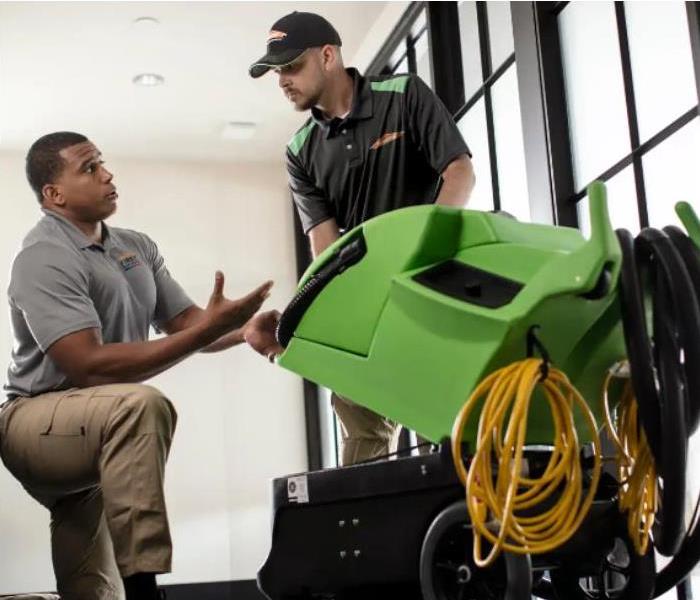 Whether it's cleaning, restoration, or construction, SERVPRO® of Moore is a one-stop shop for all your mitigation or restoration needs.
Whether it's cleaning, restoration, or construction, SERVPRO® of Moore is a one-stop shop for all your mitigation or restoration needs.
SERVPRO® of Moore water extraction services are designed for significant events like natural disasters, roof leaks, burst pipes, drainage problems, sewage backups, and whatever devastating situation could result in water damage in your home. This process ultimately removes all the visible water, speeding up the drying process and preventing the risk of further structural damage. Water mitigation, on the other hand, is more of a professional cleanup done after the water extraction process. Water mitigation cleans, sanitizes, and dries out the property. This swift action minimizes water damage by removing unsalvageable contents, disinfecting, and removing nasty smells, as well as thoroughly drying the building structure.
The difference between the two processes is the order in which they come in and the role they play in water damage restoration. Water extraction comes first, followed by the water mitigation process.
Even the smallest amount of water can be destructive, which is why it is important that water extraction be carried out first. In contrast, water mitigation stabilizes the property, keeping its integrity intact and making it fully dry for repairs to take place.
Why Are Water Extraction and Water Mitigation Necessary?
Water mitigation and extraction stop further water harm to a structure. Both entail removing water while maintaining the structural integrity of the building. If not handled properly, water infiltration can seriously harm a building’s structural elements, such as the foundation, walls, and flooring.
For this reason, both water extraction and water mitigation are important. They both support building safety and guard against health and financial risks brought on by water damage.
Contact SERVPRO® of Moore Today
After experiencing water damage, your priority should be contacting SERVPRO® of Moore for water extraction services.Our team of expert technicians works effectively to restore homes and buildings affected by water damage to pre loss conditions.
Step-by-Step Guide to Cleaning Up Water Damage in Your Property
3/27/2023 (Permalink)
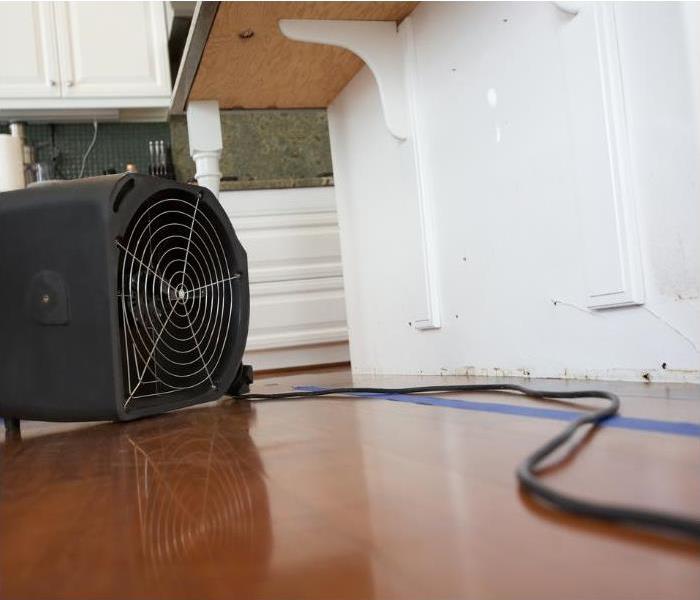 Removing water quickly helps reduce drying time and helps prevent secondary damage to your structure and flooring.
Removing water quickly helps reduce drying time and helps prevent secondary damage to your structure and flooring.
Step 1: Identify the source of the water
In cleaning up water damage is to identify the source of the water. This will help you determine the type of water (clean, gray, or black) and the appropriate steps to take for removal and cleanup. Some common sources of water damage include broken pipes, leaking appliances, and flooding from heavy rainfall or storms.
Step 2: Extract and dispose of standing water. Once you've identified the source of the water, the next step is to extract any standing water and dispose of it properly. This will help prevent the water from spreading and causing further damage to your property. Use a wet/dry vacuum or a sump pump to remove standing water, and dispose of it according to local regulations.
Step 3: Dry out affected areas
After removing standing water, it's important to dry out any affected areas to prevent mold growth. Use fans, dehumidifiers, and air movers to circulate air and speed up the drying process. It's also a good idea to remove any wet materials, such as carpeting or drywall, that cannot be salvaged.
Step 4: Restore damaged items and surfaces
Once the affected areas are dry, you can begin the restoration process. This may involve cleaning and disinfecting any items or surfaces that were damaged by the water, such as furniture, clothing, and walls. If necessary, you will need to hire SERVPRO of Moore to help with the restoration process.
The Basics of Water Damage
3/22/2023 (Permalink)
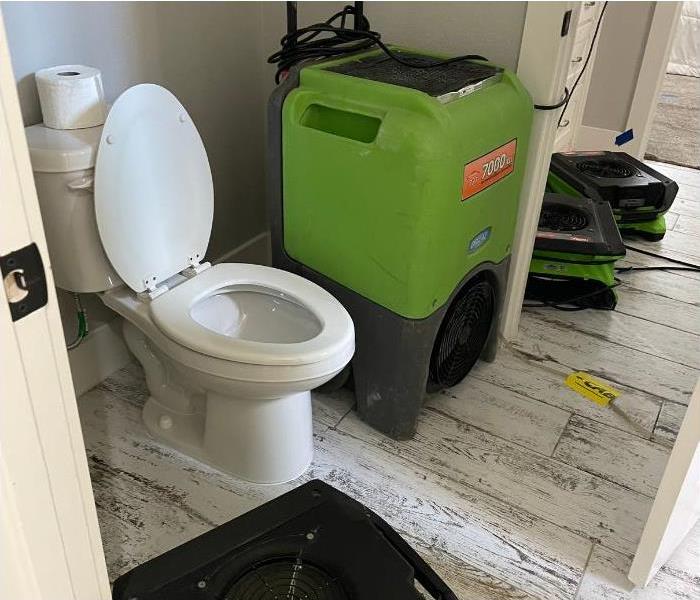 Client had a toilet leak that caused water damage to residential property, we placed dehumidifiers to remove moisture
Client had a toilet leak that caused water damage to residential property, we placed dehumidifiers to remove moisture
Water damage is a widespread issue that can be caused by many different causes. Pipes break, sinks and toilets overflow, roofs leak, and more can all lead to this problem.
When homeowners experience water damage, it’s essential they contact SERVPRO of Moore immediately. We’re specialists in cleaning up and restoring properties that have been affected by floodwaters.
Water damage restoration begins with an inspection and assessment. Whether due to a burst pipe or natural disaster, conducting an exhaustive examination is paramount in order to safeguard your home and personal belongings from further harm.
A comprehensive assessment can accurately measure the extent of water damage, identify potential hazards and craft a strategy to resolve them. It also serves as an essential step when filing insurance claims and scheduling repairs.
If you detect signs of water damage, don’t hesitate to contact a reliable restoration company like SERVPRO of Moore. We will guide you through the process of repairing your property quickly and effectively.
Once an initial assessment is conducted, SERVPRO will provide you with an assessment of damages and an estimate for cleanup and restoration costs. This information can be invaluable when dealing with insurance companies or contractors eager to begin work as quickly as possible.
Once the damages have been identified, technicians can begin to extract moisture. They may use equipment like air movers and dehumidifiers to expedite this process.
This process is necessary to prevent hidden mold growth from taking hold. Mold poses a serious health hazard, potentially leading to respiratory illness and allergies.
Water damage, if left unchecked, can have devastating effects on a structure and even lead to collapse. If left unchecked, water damage could potentially destroy everything in its path.
Water damage is one of the most hazardous scenarios that can happen to a residential or commercial property. Not only does it cause extensive structural damage, but also damages furniture and other belongings as well as opening the door for mold growth.
Clogged Toilet Can Cause Water Damage
1/26/2023 (Permalink)
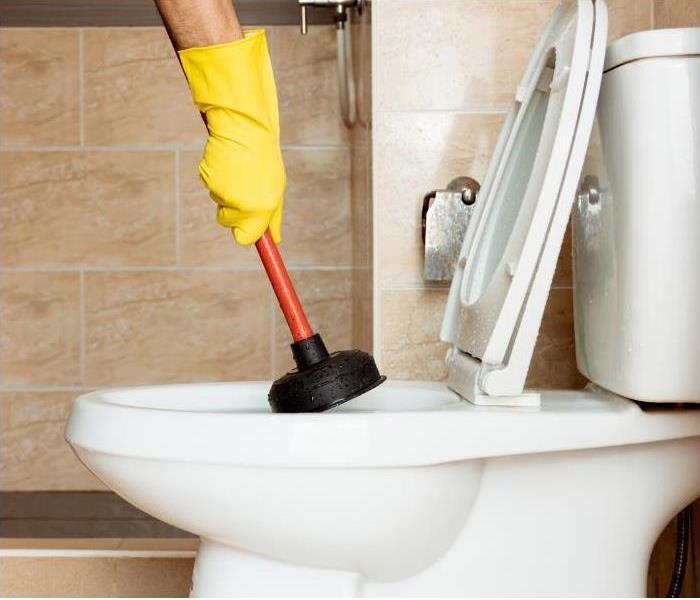 A residential bathroom toilet clogged causing water damage
A residential bathroom toilet clogged causing water damage
When you think of overflowing toilets, you may picture a small flood confined to your commercial bathroom. However, if this type of overflow goes unnoticed, your commercial building could have much more extensive sewer damage. The unattended water may travel down walls and through ceilings to affect two floors or more. When this major destruction takes place, you need to call SERVPRO of Moore Equipped with the necessary safety apparatus and cleaning products, we can help transform these unhealthy environments back into clean, safe homes and offices..
- Stop the flood. A flooded toilet may continue adding water to your building unless you cut off the water supply. Turning off the water may help minimize the damage or at least stop it from getting worse.
- Tear out materials. Because you're dealing with sewer damage, any materials or furnishings that got wet may need to be removed and thrown away. This can include flooring, drywall, insulation and ceiling materials. These items often have to be tossed because sewage usually contains fecal matter, viruses, bacteria, chemicals and other potentially harmful contaminants.
- Disinfect the space. Once the items that can be torn out have been, you need to make sure your commercial space is thoroughly cleaned. The cleaners used will depend on the type of surface getting cleaned, but any sewage company that often deals with this type of cleanup will have the cleaners and equipment needed to get the job done right.
- Dry out the space. Putting dehumidifiers to work ensures your building is rid of excess moisture. If extra water remains, even in the form of humidity, you may have to deal with mold growth in the future.
- Repair the damage. The final step in this cleanup process is repairing any of the damage that was done. If building materials were torn out, they need to be replaced to return your building to normal.
Sewer damage requires an extensive cleanup to ensure your building is safe for inhabitants. If you skip any important steps, you may have to deal with secondary damage sometime down the road
WATER DAMAGE VS. FLOOD DAMAGE
1/24/2023 (Permalink)
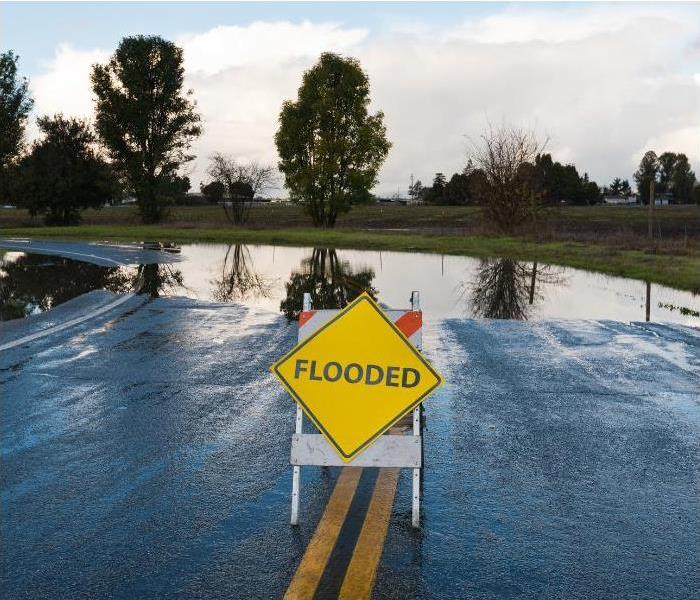 a flooded road with a warning sign
a flooded road with a warning sign
WHAT IS WATER DAMAGE
SERVPRO®? of Moore wants you to Imagine this: You're home, sleeping. Your spouse wakes you up after returning from their late-night bathroom trip and says the toilet is flowing like Niagara Falls (and for some reason, these things only happen late at night when everything is closed).
This unfortunate incident is considered water damage. Water damage usually results from an internal issue within the house (i.e., the above toilet scenario or your pipes bursting). It is different from Flood Damage.
FLOOD DAMAGE
Flood Damage is usually caused by Mother Nature raging outside your home. For example, when Claudette flooded your living room and ruined all the furniture, or a creek bed overflows during heavy rain.
Unlike water damage, flood damage comes from natural sources like storms, lakes, rivers, and streams, and the difference is huge in terms of how and if you can file claims.
WHAT THIS MEANS FOR YOUR COVERAGE
Pull out your insurance policy right now and look over it. Most likely, you have coverage for water damage (but always double-check as some insurance policies will only cover certain types).
Generally, most homeowners insurance policies don’t cover flood damage. So what can you do? Make sure to research and consider purchasing a flood insurance policy.
SERVPRO®? of Moore TO WRAP UP:
Although they seem similar, the difference between flood damage and water damage is significant when it comes to your homeowner’s policy coverage and what you pay out of your wallet.
In general, flood damage results from a natural disaster like a tropical storm. On the other hand, water damage is caused by something in your home, like burst pipes. Your insurance policy generally covers water damage. But unless you specifically purchase a flood insurance policy, you’ll be footing the bill for any natural disasters yourself.
How To Prevent Common Causes Of Water Damage
1/19/2023 (Permalink)
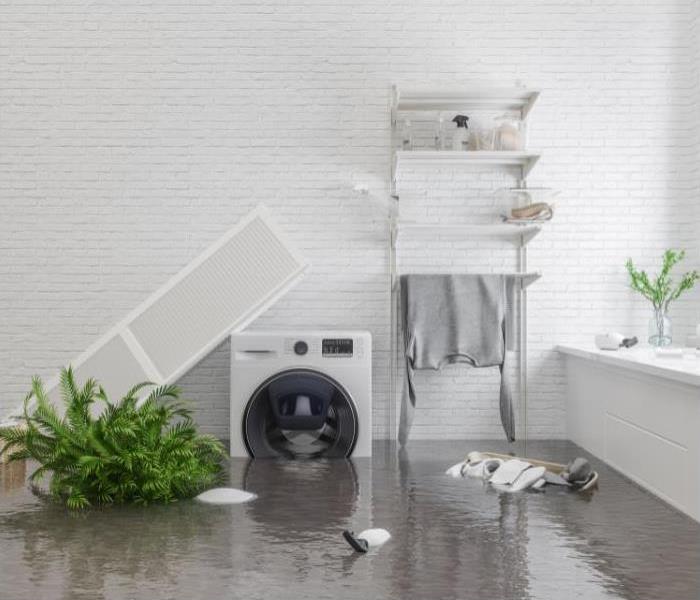 water damage
water damage
Water damage can cause all sorts of problems when inflicting a home. These can include structural damage and mold growth, both of which are extremely dangerous to anyone living on the property. Taking care of water damage is essential when ensuring the safety of any residents. Water damage can spread quickly, and the longer it sticks around, the more damage that will occur. SERVPRO of Moore wants you to know acting now is the best way to minimize both damage and any hazards that come along.
Natural Causes
Properties can sustain serious water damage from all sorts of natural disasters that cause water damage. Floods and heavy rainstorms are among the most common reasons for natural causes of water damage. Though these disasters don’t tend to occur every day, there is still a reason to ensure that your home is stable and strong enough to withstand damage.
With that being said, here are some SERVPRO of Moore preventative measures that can be taken to waterproof your home. This ensures that no water can make it from outside the home to the inside and cause water damage. You can walk outside the exterior of the house and run down a checklist of items you will need to investigate. Gutters and downspouts are a huge aid in keeping water outside of the home, particularly when you are experiencing heavy weather. Be sure that these are always kept clear, sealed, and intact.
You will also need to inspect the roof for missing or broken shingles. These can lead to leakages in the attic. This needs to be repaired as soon as possible and, most importantly, before a storm.
Check door frames and window frames to ensure that everything is sealed properly. Separation, crack, or soft spots are signs that the sealant isn’t as effective as it is meant to be. If you notice any of these, be sure to repair them immediately to avoid water damage.
Internal Causes
Water damage can also come from inside the house. Water is utilized in our daily lives, so naturally, accidents are bound to happen. Most commonly, issues like these come from burst pipes, malfunctioning appliances, and faulty plumbing. Unfortunately, these problems can go under the radar, since they aren’t usually as explosive as natural disasters. Watching for signs of water damage is essential to avoid large amounts of damage.
On walls, ceilings, and floors, watermarks will start to appear. These may look like darker or yellowing spots, as well as water rings present. Textures in the walls/ceilings may also change. These changes can include flaking, bubbling, or cracking in the drywall or paint. Additionally, walls may feel soft to the touch. Paint can also begin to sag if it is holding enough water behind it. Tile, laminate, or wood flooring will warp, crack, or split if it has been affected and water will continue to seep through. Be sure to go through your home and check the flooring, even if they aren’t visually changed. They could also feel damp or soft.
Why You Should Hire Restoration Specialists
1/13/2022 (Permalink)
So, you had a water leak, and you’re not sure if you can handle the job yourself or if your situation requires a team of professionals. There are many reasons why you should always have your property inspected by professionals after a water loss.
SERVPRO® of Moore utilizes the correct equipment and our professional knowledge and expertise to get the restoration process completed as quickly as possible, returning your home to pre loss condition in most cases.
Here are additional reasons why you should always hire professionals to mitigate water damage.
Part 1:
- Health and Safety: A professional company will assess if there is any contamination from gray or black water. They will also assess whether or not there is any microbial growth or mold, and remediate if detected.
- Efficiency: Our experts work quickly so you can get your schedule and routine back on track. Extending the time for remediation by hiring the wrong company or attempting to do it yourself will only further complicate an already uneasy situation.
- Mold: Mold is present after moisture has occurred. Whether it’s rain, burst pipes, ice dams that have leaked into a roof or even excessive humidity, the main culprit of mold growth is time. Mold growth can begin to occur within 48 hours of moisture's appearance.
Why Replace When You Can Restore?
11/8/2021 (Permalink)
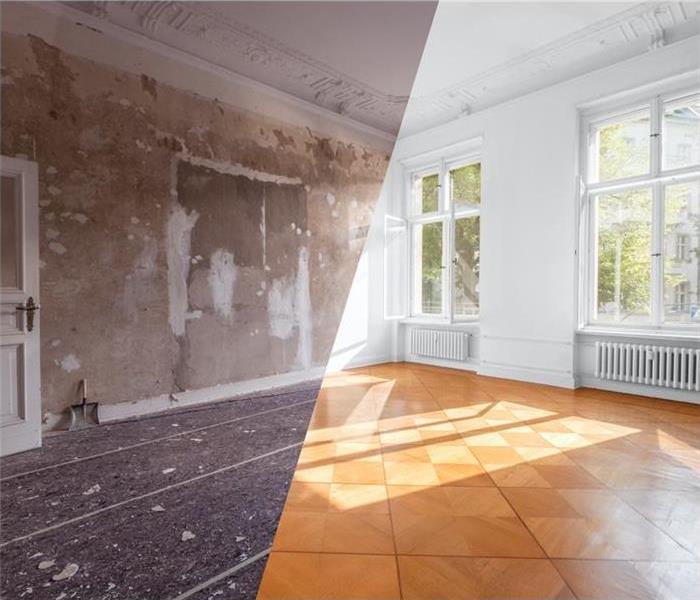 Our motto is restore rather than replace, and we have a few reasons behind it.
Our motto is restore rather than replace, and we have a few reasons behind it.
Here at SERVPRO® of Moore, our motto is that it’s always better to restore than replace.
Why do we believe this so firmly? Let’s first understand the difference between restoring and replacing. Restoring means to bring back to its original condition, while replacing means to substitute the original with an equivalent.
At first glance, replacing may seem like the way to go but we’re here to show you the raw benefits of restoration.
Restoration maintains the character.
Older houses and buildings oftentimes have iconic historic elements, whether it be vintage cabinets or doors. If these items are destroyed by a flood, any replacement you find will never compare to the original elements. By restoring these keepsakes, you’re able to preserve the look and feel of your home or business.
Restoration is cost-effective.
It may seem like replacing would save more money as you may have to purchase tools and products (or a service) to restore your home items, but in reality, restoration is much cheaper in the long run. You need to be critical when thinking of getting rid of a time that is made from older, more durable materials that have proven to last through the generations. When you replace an item, you will often be required to continue to replace it frequently over time.
Restoration takes less time.
Restoration happens as quickly as you want it to, as you’re taking the matter into your own hands. However, replacing items like windows or doors has a much slower turnaround and can take a few months until they’re made (and remember, you have to think of installation time too).
Restoration is better for the environment.
Restoration is a much greener solution as it reduces the amount of waste. Think of all the landfills that are packed with discarded doors, windows and cabinets that easily could’ve been restored.
All things considered, your return on investment is much greater when you restore items, especially when measured over a long period of time.
Call Us Today
Before you replace, give SERVPRO® of Moore a call 24/7 for any restoration needs: (405) 289-9401.
Types of Odors Impacting Your Business
11/8/2021 (Permalink)
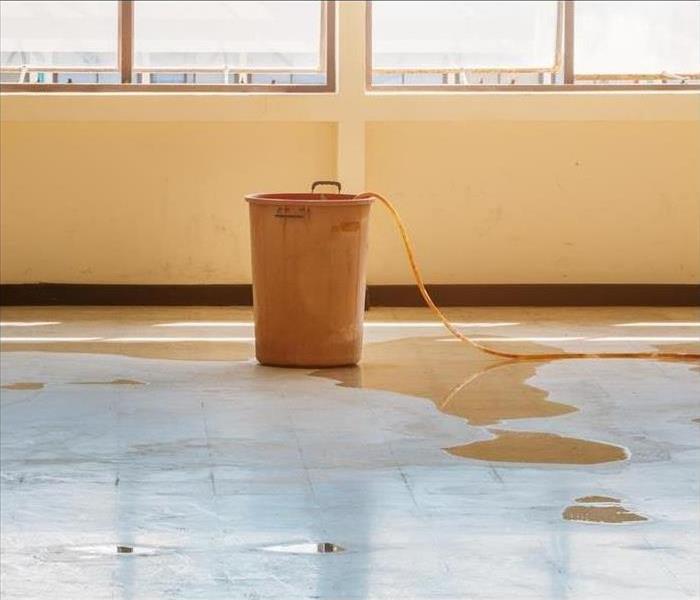 Flood damage is one of three common causes of foul odors in your commercial property.
Flood damage is one of three common causes of foul odors in your commercial property.
Lingering odors can cause a lot of problems for your business, so it’s important to know the different types of odors and what their main cause is so you can identify and eradicate them.
Odors are typically the product of a fire, flooding or infestation of mold, each having their own causes, attributes and ways to remediate them. The important part to remember is you must discover the cause of the odor before you do anything else. Only then can you find the appropriate response and solution to the problem.
At SERVPRO® of Moore, we hope to not only serve you in all of your restoration needs but also be an educational resource so you can be prepared in the case of an unfortunate event. Here are some different types of odors and what their typical cause is:
Odors from fire
Odors that result from fire are often smoky smelling and can be caused by soot, smoke damage to materials such as wood or entrapped smells within walls, furniture or even clothes. If the cause is soot, it is typically easy to identify as it appears black and powdery in appearance. Smoke can also be the underlying issue from burned food or a larger building fire and can consist of different fumes and chemicals, so it’s best to act quickly in eradicating this odor. Those who work or reside in the building can have their health compromised from these lingering odors.
Odors from flooding
These odors are typically pungent smelling and can be caused by sewage, growth of bacteria and mold/mildew. An example of this occurs if there is a burst pipe in which the sewage and wastewater will diffuse this odor. This flood water also contains bacteria that can absorb into porous furniture and provide a health hazard to those in the building.
Odors from infestations of mold
This odor is described as earthy, stale and damp. Mold that is left alone for too long can grow, which results in the production of gases that are known as microbial volatile organic compounds. These gases are basically the waste products of mold, leaving a musty odor to disperse through the building.
Overall, it’s best practice to act quickly when you notice an odor, even after the restoration process is complete. You never know how the bacteria within these odors can impact you and the people within the building.
Caring for Your Belongings After an Emergency
11/8/2021 (Permalink)
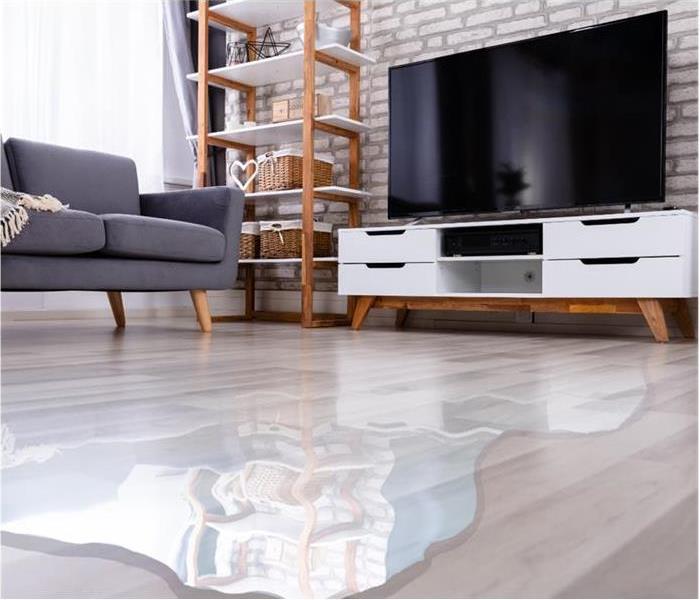 Standing water damage in a residential living room threatens to damage home electronics and other precious belongings.
Standing water damage in a residential living room threatens to damage home electronics and other precious belongings.
SERVPRO experts understand that your home or commercial property is more than just a structure; fire, water, and storm damage can affect your belongings as much as they affect the structure itself.
So what do you do to care for your belongings after an emergency? The answer is multi-faceted.
Contents Restoration
First, with the help of SERVPRO of Moore experts, assess what items can be restored. Our teams can pretest your belongings to determine what can be restored via one of a handful of safe and effective cleaning methods.
They include:
- Dry Cleaning - Used to clean light residues or to pre-clean items that will ultimately need a deeper cleaning.
- Wet Cleaning - Used to remove moderate to heavy residues.
- Spray and Wipe - Effective for items that cannot withstand wet or dry cleaning.
- Foam Cleaning - Used for upholstery fabrics that might shrink or bleed if cleaned by other means.
- Abrasive Cleaning - Involves deep scrubbing to create agitation of the surface being cleaned.
- Immersion Cleaning - Belongings are dipped into a bath of the cleaning product.
SERVPRO experts always seek to “restore” rather than “replace” whenever possible. This not only helps preserve your precious keepsakes but can also save you the money to replace items not covered by your insurer.
Learn more about our restoration cleaning methods.
Electronics
Of course, some of your most vulnerable possessions when water damage strikes are your electronics, and water-damaged electronics can present a dangerous hazard in your home or commercial property.
First and foremost do not attempt to turn on or operate any electrical device that you suspect has been damaged by water. Allow an expert to coordinate the restoration of impacted electronics like televisions, and computers. We work with qualified electronics technicians who are trained to safely clean and inspect your damaged electronics.
And when it comes to salvaging water-damaged electronics, time is of the essence. Those experts act swiftly, starting with a thorough cleaning of the exterior to prevent further corrosion and damage. However, to reiterate, urgency should never take precedence over personal safety. Our teams at SERVPRO of Moore are faster to any disaster, and we take calls 24 hours a day.
Documents & Photographs
Important documents and photographs should be handled with great care if damaged. Mishandling of these items can exacerbate damage beyond the point of restoration.
While some documents might not be restored to perfect condition, SERVPRO experts can do a tremendous amount to minimize damage by employing a combination of…
- Air Drying
- Dehumidification
- Freezer Drying
- Vacuum Freeze Drying
- Vacuum Thermal Drying
We are experts at contents restoration and will guide you through the process to preserve your important belongings.
Why Replace When You Can Restore?
10/25/2021 (Permalink)
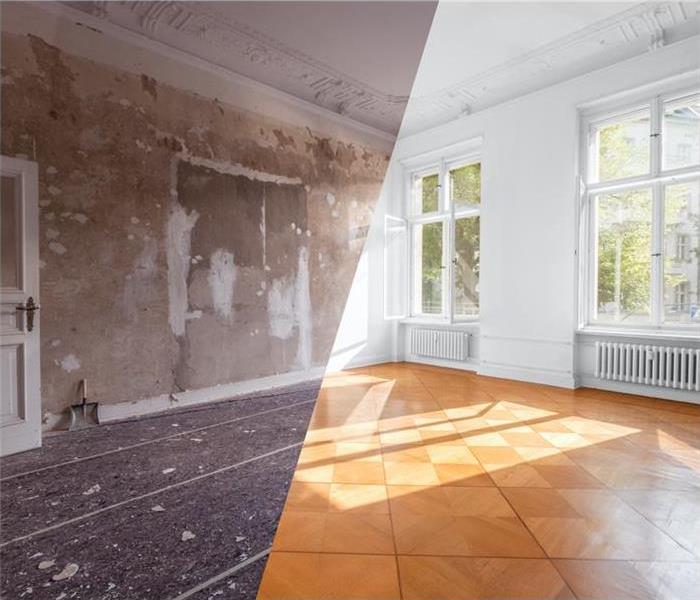 Our motto is restore rather than replace, and we have a few reasons behind it.
Our motto is restore rather than replace, and we have a few reasons behind it.
Here at SERVPRO® of Moore, our motto is that it’s always better to restore than replace.
Why do we believe this so firmly? Let’s first understand the difference between restoring and replacing. Restoring means to bring back to its original condition, while replacing means to substitute the original with an equivalent.
At first glance, replacing may seem like the way to go but we’re here to show you the benefits of restoration.
Restoration maintains the character.
Older houses and buildings often times have iconic historic elements, whether it be vintage cabinets or doors. If these items are destroyed by a flood, any replacement you find will never compare to the original elements. By restoring these keepsakes, you’re able to preserve the look and feel of your home or business.
Restoration is cost-effective.
It may seem like replacing would save more money as you may have to purchase tools and products (or a service) to restore your home items, but in reality, restoration is much cheaper in the long run. You need to be critical when thinking of getting rid of an item that is made from older, more durable materials that have proven to last through the generations. When you replace an item, you will often be required to continue to replace it frequently over time.
Restoration takes less time.
Restoration happens as quickly as you want it to, as you’re taking the matter into your own hands. However, replacing items like windows or doors has a much slower turnaround and can take a few months until they’re made (and remember, you have to think of installation time too).
Restoration is better for the environment.
Restoration is a much greener solution as it reduces the amount of waste. Think of all the landfills that are packed with discarded doors, windows and cabinets that easily could’ve been restored.
All things considered, your return on investment is much greater when you restore items, especially when measured over a long period of time.
Call Us Today
Before you replace, give SERVPRO® of Moore a call 24/7 for any restoration needs: (405) 289-9401.



 24/7 Emergency Service
24/7 Emergency Service










